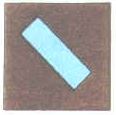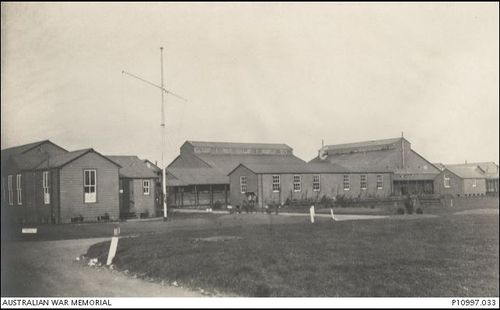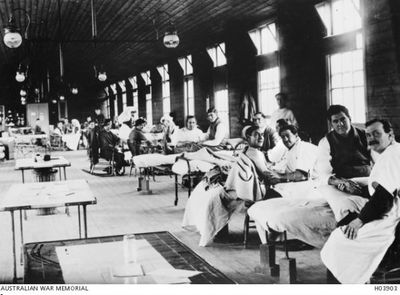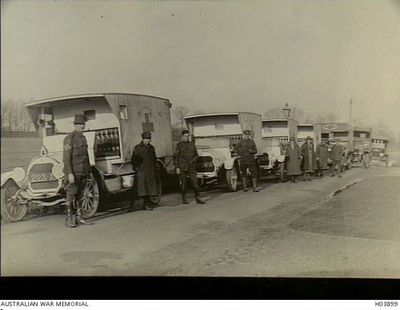3rd Australian Auxiliary Hospital
From Our Contribution
 Colour Patch of 3rd Australian Auxiliary Hospital | |
| History | |
|---|---|
| Name | 3rd Australian Auxilary Hospital |
| Where formed | England |
| Date formed | 9 Oct 1916 |
| Capacity | 1,200 patients |
| Locations | Dartford, Kent |
General Information
The second 'River Hospital', the Orchard Hospital opened just south of the Long Reach Hospital in Joyce Green Lane, Dartford in the spring of 1902 as another temporary hospital for smallpox patients. Built on 63 acres belonging to the Joyce Green estate, it had cost £135,359 and had 800 beds. The Hospital, made of iron and wood, was furnished with surplus furniture from the nearby Gore Farm Hospital in Dartford. Gas lighting was used in all the wards.
In 1910, with the decline of smallpox outbreaks, the service was reorganised and the Hospital became a fever hospital. It spent much of its time closed, being opened only for epidemics, mainly of scarlet fever and diphtheria.
It was empty at the outbreak of WW1 but in 1915 it became the Orchard Military Hospital for sick and wounded soldiers. On 16 Oct 1916 a unit previously known as the 1st Australian Stationary Hospital was renamed as the 3rd Australian Auxiliary Hospital under the command of Lt.-Col. H. Arthur Powell. Previous service as 1st Australian Stationary Hospital had been on Lemnos and the Suez Canal area of Egypt.
The Australians greatly improved the site, even adding an operating theatre. In April 1917 the Australian Red Cross took control of the Red Cross store, which ambulant patients could visit to get items that would make their stay more comfortable. Bed-ridden patients were visited by the store workers and given cigarettes and chocolate. Every patient received 30 cigarettes a week.
The number of beds increased from 800 to 1000, and finally to 1200; additional nursing staff was provided by the Women's Army Auxiliary Crops. From October 1915 until December 1918, 56,441 troops had been treated. At the end of 1918, when the war had been over a month, 884 soldiers still remained in the Hospital. Many of the soldiers married local Dartford women.
The Australian government later presented the town of Dartford with a German gun, captured by the Australians, in appreciation of the hospitality extended to the troops during the war (the gun was later sent for scrap during WW2 when metal was needed for the war effort).
It developed specialist skills in dealing with those who suffered severed injuries, damage to the nervous system, and war related neuroses. Only one Australian is buried in Dartford's Watling Street Cemetery.
Nursing staff levels in 1918 were 1 Matron; 20 Nursing Sisters;36 Staff Nurses; 6 Masseuses
Staff
- Inez Clare Cronin 29 May - 13 Jul 1917
- Patrick Francis Fitzgerald 10 Aug 1918 - 1 Jun 1919
Soldier Patients by date admitted
Egypt
1915
- Thomas Edward Raine 11 Aug 1915 - 24 Aug 1915
- William Henry Shade 14 Aug - 3 Sep 1915
- Ronald Adolphous Julian Batt 25 Aug - 10 Sep 1915
- John Charles Hutchinson 7 Sep - 30 Oct 1915
- John Harold Coffen 21 Sep 1915 - ?
- Albert Stephenson Jackson 2 - 19 Oct 1915
- Frederick Thorneycroft Plant 7 Nov - 28 Dec 1915
- James Owen Horrocks 8 - 11 Dec 1915
- William Buck 9 - 11 Dec 1915
- George Chistopher Dalziell DCM 15 - 22 Dec 1915
- Bernard O'Reilly 15 Dec 1915 - 4 Jan 1916 Post WW1
1916
- William Henry Shade 7 - 22 Feb 1916
- George Wales McGillivray 9 - 23 Feb 1916
- William Mathews 25 Feb - 6 Mar 1916
- Ronald Adolphous Julian Batt 28 Mar - 16 Apr 1916
- Reuben Douglas Naughton 22 Apr - 10 Jun 1916
- † Herbert George Lewis 23 - 28 Apr 1916
- William Augustus Povah 26 Apr - 12 May 1916
- William Buck 27 Apr - 14 May 1916
- Herbert William Coxhead 20 - 25 May 1916
- Thomas Allan Bottrell 19 May - 13 Jun 1916
- Alfred Cecil Clarence Curtis 20 May 1916 - ?
- Walter Raymond Farnham 25 May - 9 Jul 1916
- Henry Melville Hardinge 3 Jun 1916
- William Buck 10 - 14 Jun 1916
- Percy Francis Keenan 13 - 19 Jul 1916
England
1916
- Albert John Llewellyn Reed 6 Jul 1916
- Charles Henry Davis 6 Sep - 2 Oct 1916
- Alexander Russell Main 10 Oct - 10 Nov 1916
- William Hart 20 Oct 1916 - 2 Jan 1917 - Post ww1 men
- Leo Patrick Kane 17 Oct - 11 Nov 1916
- Henry Thomas Cockram 9 - 28 Nov 1916
- Frank Moore 30 Nov - 18 Dec 1916
- Charles Rudolff Dumps 1 - 11 Dec 1916
- Frank Moore Dec 1916
- Albert Cornelius Jesse Verrier ? - 18 Dec 1916
- John Harold Rupert Smith 4 Dec - 26 Apr 1917
- Robert Poole 20 Dec 1916 - 14 Jan 1917
1917
- William Plant 9 - 28 Jan 1917
- Thomas Henry Rice15 - 19 Jan 1917
- Aubrey Cecil Dawson 7 Mar - 10 Apr 1917
- William Edgar Rowe 7 - 17 Mar 1917
- Terry de Bohun Helm 22 Mar - 11 Apr 1917
- Charles Henry Partridge 2 May - 7 Jun 1917
- William Henry Gibbs 14 - 18 May 1917
- Francis William Singleton 16 May - 7 Jun 1917
- John Goffin 28 May - 18 Jun 1917
- Francis William Singleton 8 - 13 Jun 1917
- John Harold Coffen 29 May - 25 Jun 1917
- Leonard Henry (Lennie) Buckingham MM ? Jun - 6 Jul 1917
- Arthur Leworthy Bettenay 22 - 25 Jun 1917
- Robert Lightbody 22 Jun - 5 Jul 1917
- Robert Melville Salter 13 - 15 Jul 1917
- Alexander Donald 13 -17 Jul 1917
- George Sanderson 13 - 30 Jul 1917
- William Grenfell 23 - 30 Jul 1917
- Sylvanus Benjamin Buckland 23 Jul - 6 Aug 1917
- George William Piesley 24 Jul - 15 Aug 1917
- William Rawlinson July 1917
- Ernest Alfred (Jack) Lewis 7 & 8 Aug 1917
- Sidney Francis Till 17 - 20 Aug 1917
- Frederick Hobbs 20 Aug - 29 Sep 1917
- Edward Dudley Mann 22 Aug - 12 Sep 1917
- Gordon Edgar (George) Bennett 23 Aug - 23 Sep 1917
- Vernon Claude Witney Aug - Sep 1917
- John Arthur Patterson MM 27 Aug 1917
- James Lawrence McKenna 7 - 10 Sep 1917
- Gustaf Adolf Olson 17 - 23 Sep 1917
- Henry Ogilvie Allom (Jnr) 27 Sep - 11 Oct 1917
- Leslie James Godfrey 1 - 3 Oct 1917
- John Alexander Spilsbury 3 - 8 Oct 1917
- Frederick Robert Weedon 9 Oct - 12 Nov 1917
- David Alexander Sayer 10 - 24 Oct 1917
- Robert Landen Rayner 16 - 21 Oct 1917
- William Thomson 18 - 21 Oct 1917
- Benjamin Arthur McEvoy 19 - 24 Oct 1917
- William Dobson Stevens 26 Oct - 26 Nov 1917
- Edward Patrick Thomas O'Brien 29 & 30 Oct 1917
- Albert John Harris 29 - 31 Oct 1917
- Ernest Ball DCM 9 - 10 Nov 1917
- Arthur Swindlehurst MM 9 - 28 Nov 1917
- Patrick Kiely 15 - 28 Nov 1917
- Frank Moore 16 Nov 1917 - 10 Jan 1918
- Herbert James Reed 19 Nov - 5 Dec 1917
- Frank Grundy 23 Nov - 12 Dec 1917
- William James Allen 23 - 24 Nov 1917
- Hector Lionel Saw 27 Nov - 3 Dec 1917
- Leslie Hetherington 28 Nov - 10 Dec 1917
- Robert Hastings Joyce 10 - 16 Dec 1917
- John Edward Thomson 29 Dec 1917 - 19 Mar 1918
1918
- Hubert Maitland Armstrong MM 7 - 17 Feb 1918
- Frederick Fancote 8 - 11 Feb 1918
- Lancel Butcher 12 Feb - 3 Apr 1918
- Aubrey Walter (Swazz) Mead 15 Mar - 4 Apr 1918
- Sydney Chadwick McDonald 26 - 28 Mar 1918
- John Harold Coffen 28 Mar - 4 Jun 1918
- Thomas Hesketh 28 Mar - 7 Apr 1918
- Arthur Thomas Orton MM 12 - 14 Apr 1918
- Albert Ernest Elkington 12 - 16 Apr 1918
- Charles Blunt 18 -22 Apr 1918
- William Percival Nairn 19 - 22 Apr 1918
- Robert Rueben Rodgers 29 Apr - 8 May 1918
- John Alexander Adamson 3 May 1918 - 5 Jul 1918
- George Joseph Harris 6 - 13 May 1918
- Edward Patrick Barker 24 - 28 May 1918
- Vernon Claude Witney 27 May - June 1918
- William Francis Combs 28 - 31 May 1918
- Albert John Llewellyn Reed 12 Jun 1918
- Keith Herbert Sloan 12 - 14 Jun 1918
- John Harold Coffen 13 - 30 Jun 1918
- Harry Hodgson 14 - 16 Jun 1918
- Joseph George Benton Jnr 21 - 30 Jun 1918
- Leo Patrick Kane 24 - 28 Jun 1918
- Frank Myales 26 - 28 Jun 1918
- Charles Fielder 28 Jun - 2 Jul 1918
- Norman Sedrick Tonkin 28 Jun - 5 Jul 1918
- Charles Henry Partridge 1 - 4 Jul 1918
- Henry Joseph Carroll 2 - 15 Jul 1918
- Charles Blunt 10 - 28 Jul 1918
- Matthew Walsh 11 -17 Jul 1918
- Gordon Edgar (George) Bennett 17 Jul - 10 Oct 1918
- William George Martin 19 & 20 Jul 1918
- Charles John Mitchell 19 - 22 Jul 1918
- Stanley Thomas Marsh 8 Aug - 2 Oct 1918
- William Wright Casterton MM 26 Aug - 18 Sep 1918
- John Arthur Patterson MM 7 - 13 Sep 1918
- Ernest Ball DCM 9 - 12 Sep 1918
- Sidney Francis Till 19 Sep - 16 Oct 1918 (second visit)
- Frederick Hobbs 30 Sep - 3 Oct 1918
- Alfred Gittins 1 - 25 Oct 1918
- Daniel Adkins Lewis 4 - 8 Oct 1918
- James Baillie 4 Oct - 13 Nov 1918
- Thomas Percival (Percy) Hanretty 16 -23 Oct 1918
- Peter Grant Watt 23 - 28 Oct 1918
- Joseph William Smith 28 & 29 Oct 1918
- John James Thorpe 1 - 25 Nov 1918
- Walter Hayward 4 - 6 Nov 1918
- John Grant Watt MM & Bar 15 - 20 Nov 1918
- Patrick Kiely 15 - 28 Nov 1918
- George Alfred Hill 20 Nov - 1 Dec 1918
- Samuel Arthur Vincent 20 Nov - 12 Dec 1918
- Hubert Maitland Armstrong MM 2 - 8 Dec 1918
- Jesse Thomas Manser 4 - 9 Dec 1918
- Albert Nock 10 & 11 Dec 1918
- Ellis Henry Hill 17 - 21 Dec 1918
- Frederick George Gibbs 20 - 29 Dec 1918
1919
- James Francis Ottaway 2 - 27 Jan 1919
- Clarence Henry Batt 6 - 9 Jan 1919
- Frederick James Allison MM 21 - 24 Jan 1919
- Dugald Thomas Main 14 Mar - 6 Apr 1919
- Frank Myales 16 Apr - 11 May 1919
- Thomas Ramsell 30 Apr - 30 May 1919
- Ernest James Brandon Bettenay 1 -19 May 1919
- Henry Ogilvie Allom (Jnr) 23 Jun 1919




